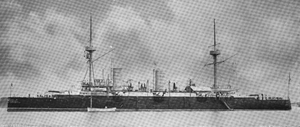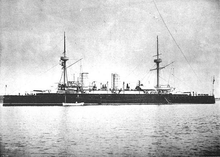Italian cruiser Stromboli
 Stromboli, probably in 1896 | |
| Career (Italy) | |
|---|---|
| Name: | Stromboli |
| Namesake: | Stromboli |
| Laid down: | 27 September 1883 |
| Launched: | 4 February 1886 |
| Commissioned: | 21 March 1888 |
| Fate: | Sold for scrap, 1911 |
| General characteristics | |
| Type: | Protected cruiser |
| Displacement: | 3,474 long tons (3,530 t) |
| Length: | 283 ft 6 in (86.4 m) |
| Beam: | 42 ft 6 in (13.0 m) |
| Draft: | 19 ft (5.8 m) |
| Installed power: | 6,252 ihp (4,662 kW) 4 cylindrical boilers |
| Propulsion: | 2 shafts, 2 horizontal compound steam engines |
| Speed: | 17 knots (31 km/h; 20 mph) |
| Range: | 5,000 nautical miles (9,300 km; 5,800 mi) at 10 knots (19 km/h; 12 mph) |
| Complement: | 12 officers and 296 men |
| Armament: | 2 × 10-inch (25 cm)/30 guns 6 × 6-inch (15 cm)/32 guns 5 × 6-pounder Hotchkiss 5 × 1-pounder Hotchkiss guns 4 × 14-inch (356 mm) torpedo tubes |
| Armor: | Deck: 1.5-inch (38 mm) Conning tower: .5 in (13 mm) |
Stromboli was a protected cruiser of the Italian Regia Marina (Royal Navy) built in the 1880s. She was the second member of the Etna class, which included three sister ships. She was named for the volcanic island of Stromboli, and was armed with a main battery of two 10-inch (254 mm) and six 6-inch (152 mm) guns, and could steam at a speed of 17 knots (31 km/h; 20 mph). Her career was relatively uneventful; the only significant action in which she took part was the campaign against the Boxer Rebellion in China in 1900. She returned to Italy in 1901 and spent the rest of her career in reserve or as an ammunition ship, apart from a brief stint in active service in 1904. Stromboli was stricken from the naval register in 1907 and sold for scrapping in 1911.
Design
Stromboli was 283 feet 6 inches (86.4 m) between perpendiculars, with a beam of 42 feet 6 inches (13.0 m). She had a mean draft of 19 feet (5.8 m) and displaced between 3,373–3,474 long tons (3,427–3,530 t). Her crew numbered 12 officers and 296 men. The ship had two horizontal compound steam engines, each driving a single propeller, with steam provided by four double-ended cylindrical boilers. Stromboli was credited with a top speed of 17 knots (31 km/h; 20 mph) from 6,252 indicated horsepower (4,662 kW). She had a cruising radius of 5,000 nautical miles (9,300 km; 5,800 mi) at a speed of 10 knots (19 km/h; 12 mph).[1]
The main armament of the ships consisted of two Armstrong 10-inch (254 mm), 30-caliber breech-loading guns mounted in barbettes fore and aft. She was also equipped with six 6-inch (152 mm), 32-caliber, breech-loading guns that were carried in sponsons along the sides of the ship. For anti-torpedo boat defense, Stromboli was fitted with five 57-millimeter (2.2 in) 6-pounder Hotchkiss guns and five 37-millimeter (1.5 in) 1-pounder Hotchkiss guns. Stromboli was also armed with four 14-inch (356 mm) torpedo tubes. One was mounted in the bow underwater and the other three were above water.[1] She was protected with an armored deck below the waterline with a maximum thickness of 1.5 inches (38 mm). The conning tower had .5 in (13 mm) worth of armor plating.[2]
Service history

Stromboli was laid down at the Venice shipyard on 27 September 1883 and her finished hull was launched on 4 February 1886. Following the completion of fitting-out work, she was commissioned into the Italian fleet on 21 March 1888.[2] Stromboli and her sisters Vesuvio and Ettore Fieramosca participated in the 1893 naval maneuvers as part of the Squadron of Maneuvers.[3] Stomboli and Ettore Fieramosca next participated in the 1896 naval maneuvers as part of the Maneuver Fleet.[4] During this period, she was assigned to the Flying Squadron, along with the armored cruiser Marco Polo and the protected cruiser Liguria. The ships were tasked as a training squadron and were also responsible for responding to any crises that might arise.[5]
In 1899 Stromboli was deployed to the Far East. She was joined by Vesuvio and Ettore Fieramosca, sent there in 1900 to assist the Eight-Nation Alliance in putting down the Boxer Rebellion in China.[1] All three ships were assigned to the Cruising Squadron in Chinese waters in 1901.[6] That year, Stromboli returned to Italy and was placed in reserve,[7] before returning to active service in 1904. That year she was in active service for seven months; she spent the rest of the year with a reduced crew, as was standard practice in the Italian fleet at the time.[8] She later served as an ammunition ship before being struck from the Navy List on 21 March 1907 and sold for scrap in 1911.[7][2]
Notes
References
- Barry, E. B., Lieut. Commander (1896). "Naval Manoeuvers of 1896". Notes on Naval Progress. Information from abroad: General information series XVI (October 1896 ed.). Washington, D. C.: Government Publishing Office. pp. 131–40. OCLC 145338985.
- Brassey, Thomas A. (1904). The Naval Annual (Portsmouth: J. Griffin & Co.). OCLC 5973345. Missing or empty
|title=(help) - Brook, Peter (2003). "Armstrongs and the Italian Navy". In Preston, Antony. Warship 2002–2003. London: Conway Maritime Press. pp. 94–115. ISBN 0-85177-926-3.
- Gardiner, Robert, ed. (1979). Conway's All the World's Fighting Ships: 1860–1905. London: Conway Maritime Press. ISBN 0-85177-133-5.
- Lansdale, P. V., Lieut. (1894). Notes on the Year's Naval Progress. Information from abroad: General information series XIII (July 1894 ed.). Washington, D. C.: Government Printing Office. pp. 354–73. OCLC 145338985.
- "Naval Notes–Italy". Journal of the Royal United Service Institution (London: J. J. Keliher) XLV (283): 1136. September 1901. doi:10.1080/03071840109418900. OCLC 8007941.
- Robinson, Charles, ed. (March 1897). "The Italian Fleet". Navy and Army Illustrated (London: Hudson & Kearns) III: 182–185. OCLC 7489254.
| ||||||||||||||